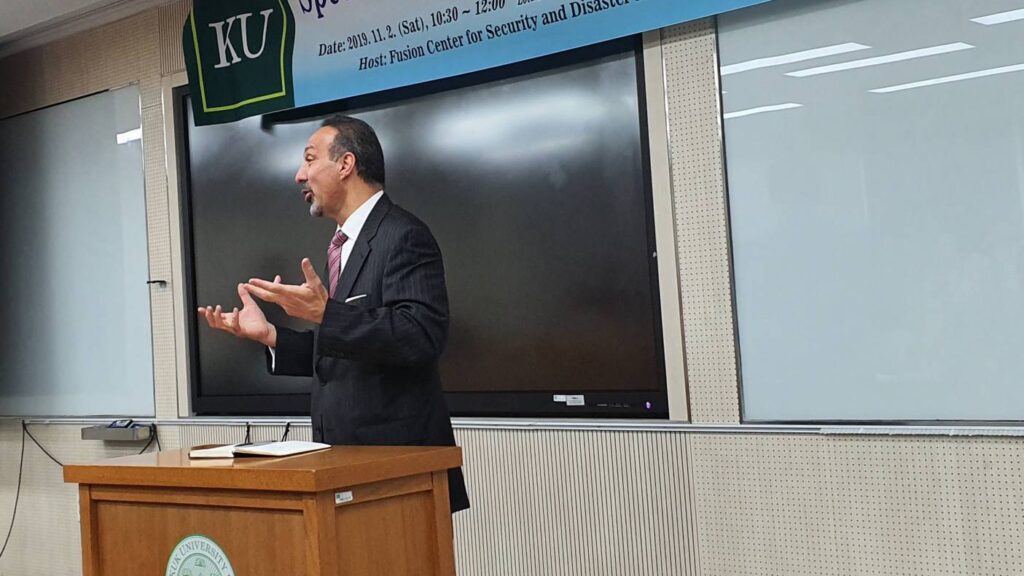Mehran Kamrava speaks at Konkuk University in Korea

On November 2, 2019, Mehran Kamrava, Director of the Center for International and Regional Studies (CIRS), gave a talk titled “Emerging Trends in the Middle East” at the Fusion Center for Security and Disaster Management, Konkuk University.
In his lecture, Kamrava looked into the next five to ten years, and noted that there are a number of consequential trends that are likely to greatly shape the nature of domestic, regional, and international politics in the Middle East. For the first time in a long time, these trends do not involve the struggle over Palestine or the broader conflict between Arab and Israelis. With the steady and unimpeded dismantling of Palestine, that struggle appears to be all but over. Instead, there are four specific trends that are likely to be of great consequence.
The first of these trends is what might be called Arab Spring 2.0. We are currently seeing the eruption of a number of social movements in parts of the Middle East that were either completely immune to popular uprisings in 2010-2011 or were only mildly impacted by them. Today, however, we see popular movements in Algeria, Sudan, Lebanon, and Iraq. Unlike the 2010-2011 uprisings that were animated by calls for social justice and integrity, this new wave of protests is inspired by demands for service delivery by state agencies, employment creation, accountability, and transparency. In Lebanon, we might even be seeing the beginning of the end of the nation’s long political tradition of sectarian politics. Will these new crop of social movements and protests have the same fate as the eelier uprisings, or will they usher in new eras of transparent and accountable politics?
A second trend to look for are developments in, and occurring because of, Saudi Arabia. In the eventful past few years that have seen his meteoric rise, the Crown Prince of Saudi Arabia, Mohammed Bin Salman (MBS), has dismantled the Saudi deep state, introduced far reaching social reforms, and has presented a new, progressive, and modernizing face of the Saudi ruling family. In foreign policy pursuits, MBS has been thoroughly reckless. His 2015 war on Yemen has not yielded desired results, has plunged the Arab world’s poorest country into further chaos and bloodshed. His 2017 blockade of Qatar has by all accounts been a failure. His refusal to talk to Iran has needlessly prolonged and deepened regional tensions. And his misadventures, like imprisoning the visiting Lebanese prime minister and the killing of the journalist Jamal Khashoggi, have been nothing other than criminal. Are we, it is worth asking, witnessing the rise of another Saddam Hussein, someone the West blindly adores until his criminality is so exposed that it can no longer be ignored?
Iran represents a third trend for observers of the Middle East to watch. Within the next five to ten years, Iran is likely to undergo a leadership transition as the Supreme Leader, Ali Khamenei, is likely to pass from the scene. Even if his successor has already been determined and pursues the same policies as Khamenei does, Khamenei’s departure after more than thirty years is bound to have significance consequences for Iranian politics. More specifically, how will the Iranian deep state react, and what political positions is it likely to adopt? Will the Islamic Revolutionary Guard Corps (IRGC) become even more politically powerful? And will the IRGC continue its close political alliance with the clergy in the same manner it does now?
Finally, will US-Iranian tensions, a constant feature of the Middle East landscape, devolve further into open war or will they be lessened? Since 1978-1979, the US efforts to impose an ideal regional security architecture on the Middle East have been steadfastly resisted by revolutionary Iran, resulting in chronic tensions between an Iran that has been seen as a source of regional instability and a US accused of regional hegemony. For the last forty years, there have been ebbs and flows to the relationship, which has, nonetheless, always been fraught. For now, the present predicament of “no war, no peace” is likely to continue. But the danger of an accidental war is ever present.
What is certain, at least in the foreseeable future, is the continuation of deep structural issues across the Middle East—unemployment, inefficient public sectors, crony capitalism, unpopular leaders, and other similar deficits—that are only likely to prolong the region’s chronic instability. By all accounts, stability, both domestic and regional, will remain elusive in the Middle East, and any of democracy even more so.